
The Y-12 National Security Complex in Oak Ridge manufactured the uranium core piece for the KRUSTY experiment, which tested a new nuclear power source that could provide safe, efficient energy for robotic and human space exploration missions. (Photo courtesy NNSA)
The Y-12 National Security Complex in Oak Ridge manufactured the uranium reactor core for a federal experiment that tested whether a nuclear energy source could provide power for space exploration.
“The full-power run showed that it may be feasible for NASA to use small fission reactors for deep space exploration and manned missions to the moon and Mars,” the National Nuclear Security Administration said in May.
The NNSA, which is part of the U.S. Department of Energy, worked with NASA (the National Aeronautics and Space Administration) on the project. It’s nicknamed KRUSTY, an acronym for Kilowatt Reactor Using Stirling Technology.
“In a joint venture with NASA last year, NNSA completed final design, fabrication, and full-power testing of a nuclear criticality experiment that can be used for a manned lunar or Mars space mission,” NNSA Administrator Lisa Gordon-Hagerty said in a post published on Twitter on Friday.
The uranium reactor core from Y-12 was delivered to the National Criticality Experiments Research Center at the Nevada National Security Site in the fall of 2017.
Oak Ridge Today wrote about the project in February. NASA shared news about the successful completion of the experiment during a press conference at the NASA Glenn Research Center in Cleveland in May.
The goal was to develop a power source that can support deep space travel and outlast existing fuel sources. The NNSA provided technical expertise.
KRUSTY was designed to test a prototype fission reactor that is coupled to a Stirling engine. Stirling technology is efficient, doesn’t require significant maintenance, and does not degrade in performance over time, the NNSA said.
Researchers designed and performed initial testing of the KRUSTY reactor design using a surrogate, or non-fissile, reactor core and resistive heating elements.
Assembly of the KRUSTY experiment began shortly after the uranium-235 reactor core, reported to be roughly the size of a paper towel roll, arrived from Y-12 in November 2017. The NNSA and NASA components were brought together, including the Stirling converters, shielding materials, sodium heat pipes, and a neutron reflector.
The uranium core, which has been described as having highly enriched uranium alloy components, is subcritical in air, the NNSA said. But it becomes critical once surrounded by the neutron reflector, which means it maintains a self-sustaining reaction of splitting uranium atoms until the reflector is removed.
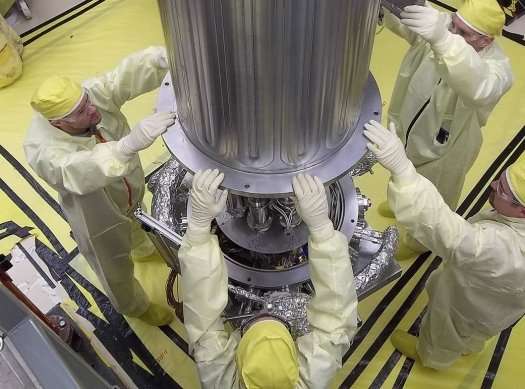
NASA and National Nuclear Security Administration engineers lower the wall of the vacuum chamber around the KRUSTY system, which tested a new nuclear power source that could provide safe, efficient energy for future robotic and human space exploration missions. The vacuum chamber is later evacuated to simulate the conditions of space when KRUSTY operates. (Photo courtesy NASA)
Researchers at the National Criticality Experiments Research Center in Nevada achieved the initial criticality in November 2017, the NNSA said.
“Since then, a series of experiments followed that helped to characterize the assembly and obtain experimental benchmark data for use by the Nuclear Criticality Safety Program,” the NNSA said. “These efforts culminated in a 28-hour continuous full-power demonstration in March.”
That full-power run is the one that showed that it may be feasible for NASA to use small fission reactors for deep space exploration and manned missions to the moon and Mars.
In May, the NNSA said Los Alamos National Laboratory, which operates the Nevada National Security Site, is currently using the KRUSTY nuclear data to develop experimental benchmarks for a variety of applications, including nuclear criticality safety, emergency response, and nuclear nonproliferation.
Experts from Lawrence Livermore National Laboratory, Sandia National Laboratories, and other NNSA field offices and production sites contributed to the completion of the design, safety analysis, fabrication, and final testing of the KRUSTY experiment.
“NASA gets a prototype demonstration for a kilowatt-range fission power source, and NNSA gets a benchmark-quality experiment that provides new nuclear data in support of our Nuclear Criticality Safety Program,” said Patrick Cahalane, NNSA’s principal deputy associate administrator for safety, infrastructure, and operations.
KRUSTY is part of NASA’s larger Kilopower project. NASA said the pioneering space power system, which would use nuclear fission, could provide up to 10 kilowatts of continuous electrical power for at least 10 years. That’s enough power to run two average households. It would provide about 10 times as much power as the multi-mission radioisotope thermoelectric generator.
Four Kilopower units would provide enough power to establish an outpost, NASA said. The system could enable long-term stays on planetary surfaces.
Reuters reported January 18 that a key hurdle for any long-term colony on the surface of a planet or moon, as opposed to NASA’s six short lunar surface visits from 1969 to 1972, is having a power source strong enough that it can sustain a base, but small and light enough that it can be shipped through space, Reuters said.
“When astronauts someday venture to the Moon, Mars, and other destinations, one of the first and most important resources they will need is power,” NASA said. “A reliable and efficient power system will be essential for day-to-day necessities, such as lighting, water, and oxygen, and for mission objectives, like running experiments and producing fuel for the long journey home.”
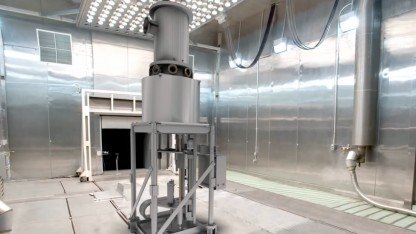
The KRUSTY Experimental Assembly is pictured above. The experiment tested a new nuclear power source that could provide safe, efficient energy for future robotic and human space exploration missions. (Photo courtesy NNSA)
The prototype power system was designed and developed by NASA’s Glenn Research Center in collaboration with NASA’s Marshall Space Flight Center and the Los Alamos National Laboratory, and the reactor core was provided by Y-12. NASA Glenn shipped the prototype power system from Cleveland to the Nevada National Security Site in late September 2017.
NASA described the advantage of the Kilopower system: “Fission power can provide abundant energy anywhere we want humans or robots to go. On Mars, the sun’s power varies widely throughout the seasons, and periodic dust storms can last for months. On the Moon, the cold lunar night lingers for 14 days.”
“We want a power source that can handle extreme environments,” said Lee Mason, NASA’s principal technologist for power and energy storage. “Kilopower opens up the full surface of Mars, including the northern latitudes where water may reside. On the Moon, Kilopower could be deployed to help search for resources in permanently shadowed craters.”
In these challenging environments, generating power from sunlight is difficult, and fuel supply is limited. Kilopower is lightweight, reliable, and efficient, which makes it just right for the job, NASA said.
See our previous story here.
See the NNSA press release here.
More information will be added as it becomes available.
Most news stories on Oak Ridge Today are free, brought to you by Oak Ridge Today with help from our advertisers, contributors, and subscribers. This is a free story. Thank you to our advertisers, contributors, and subscribers. You can see what we cover here.
Do you appreciate this story or our work in general? If so, please consider a monthly subscription to Oak Ridge Today. See our Subscribe page here. Thank you for reading Oak Ridge Today.
Copyright 2018 Oak Ridge Today. All rights reserved. This material may not be published, broadcast, rewritten, or redistributed.
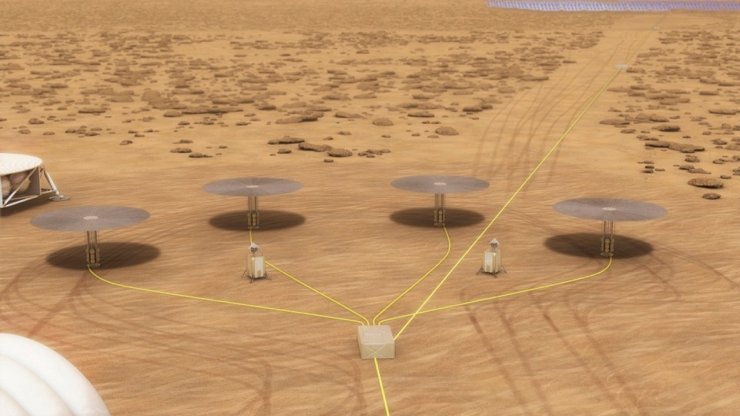
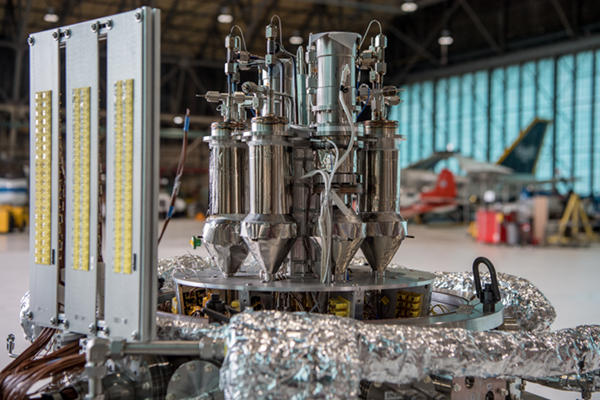
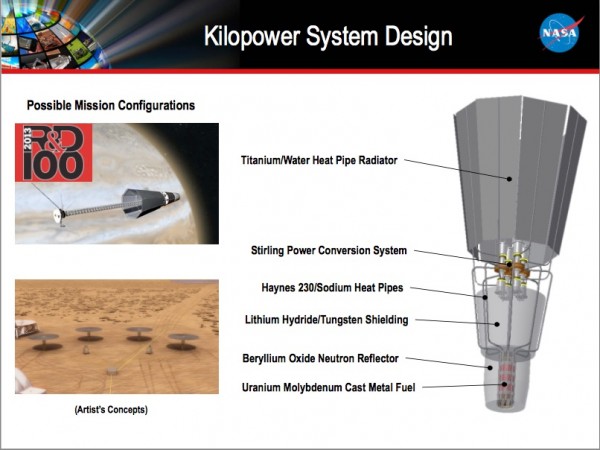
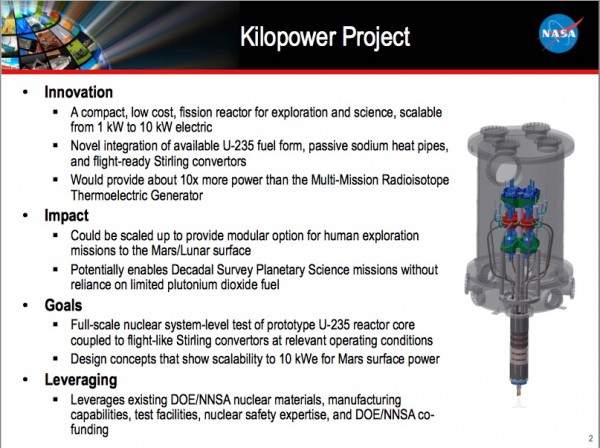
Leave a Reply